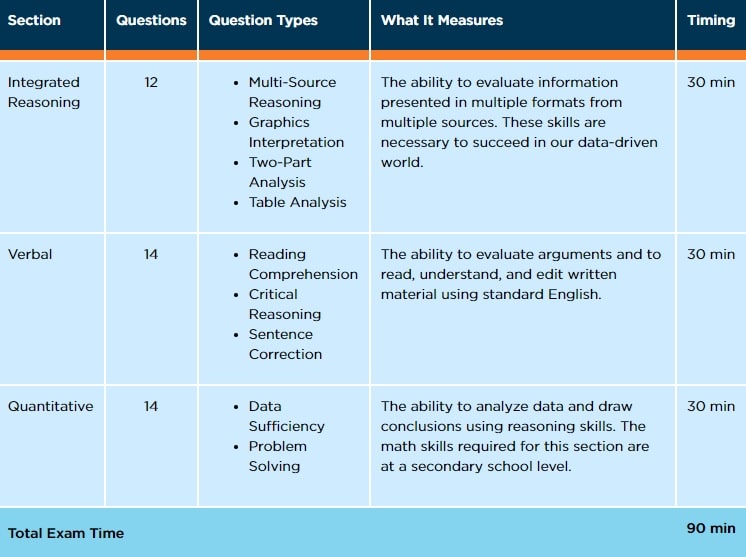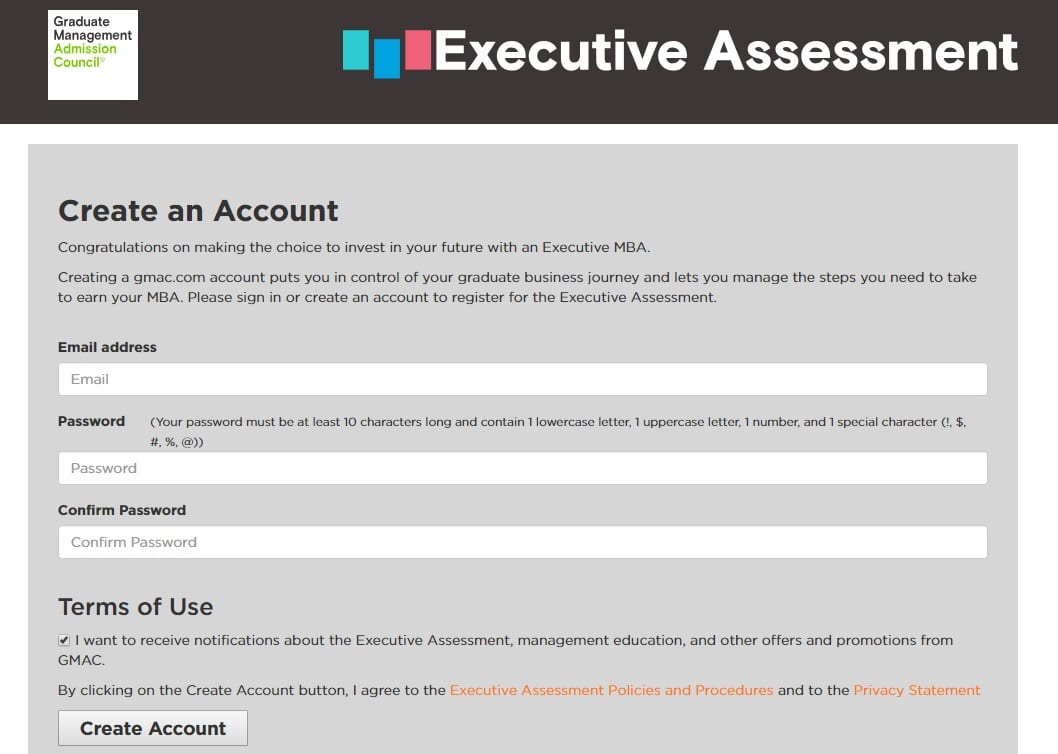The Executive Assessment (EA) test is quickly becoming THE standard admissions test for Executive MBA programs. With more than 90 business programs accepting the test as of the beginning of 2020, there is a good chance that the program you’re interested in accepts the EA.
Despite the growing approval of the Executive Assessment test, there’s not a lot of information available online about it. You can find some information buried in the test makers website, but what does that mean for the average applicant?
At Prep Executive, we’ve been teaching the Executive Assessment test to students in person from the beginning of the test (we taught GMAT before that), so we want to provide you with information that will put you at ease come test day.
Here are 10 things to know about the Executive Assessment test BEFORE you take it.
1. It’s only 1.5 hours.
You’re in, you get tested intensely, and then you’re out. Yes, the Executive Assessment test is only 90 minutes, but they manage to cram a lot into that time:
- Integrated Reasoning Section: 30 minutes, 12 (multi-part) questions
- Quantitative Reasoning Section: 30 minutes, 14 questions
- Verbal Reasoning Section: 30 minutes, 14 questions
The quant section is the “math,” while the verbal section is reading, logic, and grammar. The Integrated Reasoning Section combines both the quantitative and verbal skills and apply this knowledge to more “professional” questions that involve analyzing tables, graphs, charts, figures, and so.
Here’s the test format straight from the test maker:
Image: Graduate Management Admission Council
2. It’s not exactly a mini-GMAT.
There have been some articles written calling the Executive Assessment test a “mini-GMAT.” Well, it is and it isn’t.
Here’s what GMAC has to say:
Image: Graduate Management Admission Council
Here’s what we think:
It is a mini-GMAT
- Three of the sections are the same. IR, quant, and verbal are all on the GMAT as well.
- The general question types within each section are the same.
- Some of the questions on the Executive Assessment test are GMAT (or old GMAT) questions.
But…
There are some important differences as well.
It’s not a mini-GMAT
- There is no essay on the Executive Assessment test, while there is one on the GMAT.
- Your Integrated Reasoning score IS included in your total score on the EA, while it is not on the GMAT. This consideration makes IR extremely important on the EA, whereas it is an afterthought for the GMAT.
- The EA does not include all the math content areas tested on the GMAT.
- You can skip and go back on the EA within a group of questions, but you cannot on the GMAT.
- The level of difficulty on the EA changes between sections, not between questions like on the GMAT.
- We find that the level of difficulty of the questions on the EA is slightly lower than those of the GMAT.
At Prep Executive, we prefer to think of the EA as its “own thing,” rather than through the GMAT lens.
Why?
Because EA students are very different from GMAT students and it’s important to teach them that way.
3. You do need to prepare.
Unless you regularly add and subtract fractions or identify misplaced modifiers in your work, you probably need to prepare for the Executive Assessment test.
In fact, GMAC recommends it:
Image: Graduate Management Admission Council
However, there is a big difference between 3 to 6 months of GMAT prep and 1 to 2 months of EA prep. In fact, we have a 40 day program that gets you where you need to be without the stress and strain of going to classes or learning concepts on which you won’t be tested.
4. The Quant Section is no calculator.
Even though we use calculators at work all the time, the quant (math) section of the Executive Assessment is NO CALCULATOR.
You can only use a calculator on the Integrated Reasoning Section. A calculator will be provided at the test center so you can’t use your own.
Therefore, you need to complete most of your preparation not using a calculator. Time to brush up on those basic operations…
5. It’s kind of a CAT.
If you’ve read about the GMAT, then you know people freak out that it’s a computer adaptive test (CAT). This type of test changes the level of difficulty of the questions based on how you answered previous questions. Get a few right and the next ones are harder. Get a few wrong and the next ones are easier.
Since the GMAT is a CAT, you cannot skip or go back because the questions you are seeing are based on the way you answered previous ones.
The Executive Assessment test isn’t exactly like that…
The EA is a multistage adaptive test. As a MAT, the EA changes the level of difficulty of the section based on how well you did on the previous section. Therefore, the first section is always a medium level of difficulty. The next one will be harder or easier based on how you did on the first one.
Here’s how GMAC explains it:
Image: Graduate Management Admission Council
6. You can go back within the same module.
Since the EA is a MAT, you CAN skip or go back within the same module. A module is a group of questions within a section. On the IR, a module is 6 questions. On the other sections, a module is 7 questions. So, you can go back or skip within the same 6 or 7 questions.
7. There are no scheduled breaks.
You can take a break if you want, but your time will keep running. Considering it will probably take you at least 5 minutes to get to the restroom and back, we don’t recommend taking a break.
Be sure to prepare for 90 continuous minutes of testing.
8. You can take the Executive Assessment test just about anytime and anywhere.
Testing for the EA is done through more than 600 Pearson VUE test centers around the world based on scheduled appointments.
It’s super easy to register and pay online ($350) through the official Executive Assessment website.
If you have taken the SAT or other standardized tests during high school, you’ll find there is a lot more flexibility and availability with testing for the EA.
But…
9. You can only take it twice.
Yet, another reason to actually prepare.
If you can only take the test 2 times, you don’t want to use the first sitting as a “practice” to get to know the test because that will put extreme pressure on your second attempt.
We find that the best way to get what you want–to get into an Executive MBA program–is to prepare for the EA thoroughly the first time and take the test a second time only if there is a catastrophic failure the first time. (BTW, this doesn’t generally happen to Prep Executive students.)
10. You will receive your results immediately.
After you finish the test, the test center will print and stamp your unofficial score. There’s no long, nail biting wait to see what you got.
Many EMBA will accept this unofficial score to make an admissions decisions, so you can take the EA as close to your application deadline as possible.
Now that you know 10 important things about the Executive Assessment, it’s time to prepare!
Ready to start preparing for the EA?
Get started right now with Prep Executive’s interactive course, expert live coaching, and more. It’s 100% risk-free with the 7 Day Money Back Guarantee.
You May Also Like…
Info

20 Questions About the Executive Assessment Exam Answered
Admissions exams change over time and the Executive Assessment (EA) exam is no different. In fact, since being...
Test

How to Prepare for the GMAC Executive Assessment
In this post, we're going to breakdown exactly how to prepare for the GMAC Executive Assessment (EA). There's lots of...
Programs

Which Schools Accept Executive Assessment?
As of June 2020, more than 90 business schools accept the Executive Assessment as an admissions test. Each business...













Are there scholarships for Executive MBA programs?
Hi Eugena,
There may be some scholarships and grants available for an EMBA. The most comprehensive listing of sources to start your search I’ve come across is here:
https://executivemba.wharton.upenn.edu/emba-tuition-financial-aid/
It will take a lot of dedication on your part to find alternative funding sources; most EMBAs are funding by the student’s company or through loans. Let us know what you find so we can share with others!
Thanks for the quick overview! I was looking for something like this.
Hi,
Just wanted to clarify…the EA is a computer adaptive test but not like the GMAT?
Thanks,
Pat
Hi Pat, yes they are both computer adaptive, but in different ways. The GMAT is adaptive by question, which is why you can’t go back to previous questions. GMAT questions get harder or easier within the section as you answer. The EA is adaptive by section, so you can go back and change your previous answers within a group of questions. EA sections get harder or easier based on your performance in the last section, not question. Hope this is clear. If not, let me know.
Does the performance in IR section decides the difficulty in Verbal section and verbal’s performance decides difficulty in Quant section?
Hi Faizan,
Yes, that’s correct. The next section is harder if you do well in the previous section. You actually want the test to adapt this way because it means you are getting a lot of questions correct and your score will be higher. Hope this helps!